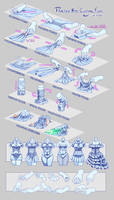It's the last week of my summer vacation, so I thought doing some clothing folds practice. The forms are quite fascinating.
The best part about drawing folds is that they are relatively simple to do by following just a handful of rules. It takes mostly a lot of patience, but otherwise it's pretty lax process since the folds are chaotic. It's also very easy to get real life references when needed, but I tend to draw everything from imagination.
For the most part there are just two types of forces influencing the forms: pulling and pushing forces. Pulling stretches the clothing while pushing compresses it. Gravity is a typical source of pulling force, as seen on curtains. While the two forces have different impact on the clothing, the forms are often very similar. When there is a force, there is also opportunities for dynamism.
What I find interesting are the "valleys" between wrinkles and how the wrinkles merge (or split). Knowing how these look, what forces are at play and understanding the context they are in does wonders.
There are a bunch of folding types, but I tend to just use logic to figure out what kind of forms will be formed. In fact, I didn't even know how they are called before I made this exercise haha! Apparently there are seven structural folds:
-
Pipe folds look just like that, pipes. Curtains hanging freely comes to mind.
-
Diaper folds are commonly suspended at two points and the fabrics hangs loosely.
-
Spiral folds are formed when the fabric twists around something. Common to see on sleeves
-
Zigzag folds happen when the fabric buckles. Very common to see on jeans and leather trousers.
-
Half-lock folds are loose pocket-like recesses that happen around joints, such as around knees and elbows
-
Drop folds take place when the fabric falls down and assume a new resting state while still supported somewhere. They tend to have many types of folds.
-
Inert Folds are very messy, such as a clothing dropped on the ground. There is no clear structure or direction on inert folds.
I drew a few objects and "threw" some cloth on them to do some draping practice. It's necessary to understand the underlying 3D forms to make the folds on top of them convincing.
Then I drew a few different clothing on a human torso. The ball dress with frills was pretty laborious but it turned out very pretty. I'm not especially well versed with clothing design so I' looked up few references and then drew these from memory/imagination.
As a side exercise, I ended up drawing a bunch of hands. I tried to use them as a context on what kind of force is being applied. They looked so neat that I decided to collect them into one group.

from DeviantArt: Popular https://ift.tt/7mDphLf
0 comments:
Post a Comment